Common Grounds
Our Friday News Analysis | In Search of a Nation's Soul (Part 13)
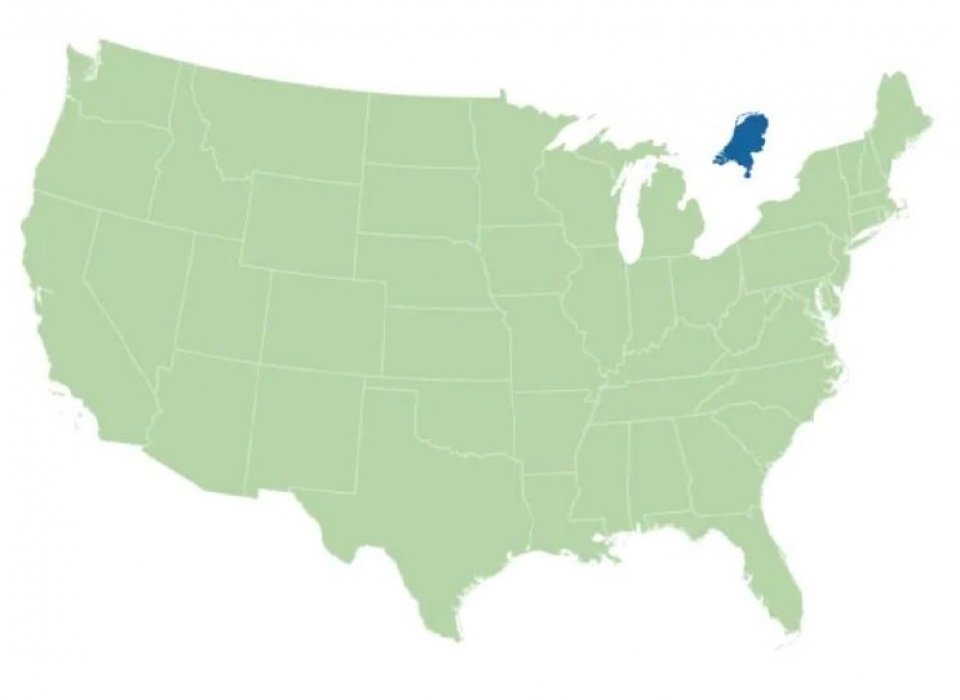
“When a dove flaps its wings in China,
the wind currents shift for thousands of miles across mountains and seas …
everything we do has a ripple effect … we’re all interconnected and have
a responsibility to look out for one another in future generations.”
We’re Putting Our Money Where Our Mouth Is
The Netherlands is by no means perfect. But, oh boy, we’re so much ahead of the game. This afternoon, after I paid for my parking spot, I called the telephone number listed to report a malfunction. I pinned 3.00 euros but didn’t receive my parking receipt from the machine to place on my dashboard. “But Dr. van Kempen, that’s the past. (How did he know my name?) You don’t need a receipt. One inspector sitting inside a specially equipped car scans the license plates of several cars simultaneously. Whoever hasn’t paid for parking will automatically receive a citation in the mail.”
In China, I don’t like big brother breathing down my neck. At home, I resent it even more. It’s a two-edged sword. Automation helps. Netherlands rank among the most technologically advanced countries in the world. We have no choice. For every 100 gainfully unemployed pensioners, we must grapple with 113 job vacancies, particularly in semi-skilled and unskilled labor. We’re building our future on the heels of American ingenuity: technology born in the USA.
Cutting-edge technology has made us a major exporter of food, second to the United States. Moreover, we can help the world feed itself by exporting our means, methods, and mechanism for many to feed themselves. We’re putting our money where our mouth is. We want to teach the hungry how to fish.
If I were the President of the United States, the Leader of the ‘Free World,’ the Dictator of the Planet, I would shift American tax dollars to invest in food production technology. I’d never be elected. For one, I’m not a US citizen. But I could never raise campaign contributions from the voters who count: owners of the Industrial Military Complex and those who hold money in money (banks and other financial institutions). Also, it would be hopeless to squeeze any funds from shareholders who own interests in all forms of energy, and natural resources, including solar and wind power, as well as oil, gas, and coal. Nor will anyone who owns stock in information, including mega social media and mass media networks, care to help fund my campaign. These industries like war. Wars serve as magnets to sell advertising. They would donate their campaign contributions to candidates who support war.
The Kremlin knows that countries like the Netherlands, Germany, France, and others in the European Union do not want nuclear craters in their backyards. Sooner than later, the EU leadership will cave into Russian demands. Another world war is unacceptable, reprehensible, and unpardonable. Ukraine is expendable. And now, with 20-20 hindsight, the people of Europe are beginning to realize that the EU-US/NATO could have prevented Russia’s response to the EU-US/NATO aggression. (Read John Mearsheimer on Putin’s Ambitions After Nine Months of War – The realist American political scientist explains why Russia’s move to annex four Ukrainian provinces isn’t imperialism, by Isaac Chotiner, New Yorker Magazine, 17 November 2022).
At press time, 30 NATO countries point 5,000+ nuclear warheads to Russia. Concurrently, 5,000+ Russian warheads target the 30 NATO countries. Compared to the EU-US/NATO Axis, Russia has much less to lose in terms of the Gross Domestic Product (GDP):
EU GDP (excluding UK) $ 16.6 trillion (World Bank estimate 2022)
EU + UK $ 19.8
US GDP $ 20.4
Russia’s GDP $ 2.13
It’s the EU-US/NATO’s $40 trillion GDP versus Russia’s $2 trillion GDP, notwithstanding Russia’s vast land mass populated by only 146 million Russians compared to roughly 800 million Americans and Europeans inhabiting the EU and the US. Moreover, Ukraine doesn’t rate. Its GDP is a mere $100.1 billion. Does it make sense that the EU-US/NATO Axis risk the lives of 800 million people to save one of the poorest and most corrupt countries on earth? The US-EU/NATO Axis should never have persisted in tormenting Ukraine to become its vassal state and proxy between East and West.
According to Forbes, the Netherlands' economy, with a GDP of $1.3 trillion, is the 15th largest in the world. Its estimated GDP per capita is $68,572 in the fiscal year 2022, which makes it one of the highest-earning nations worldwide. We don’t want to lose in less than 30 minutes what has taken us centuries to amass.
We’d prefer making friends by feeding them instead of making enemies by killing them. And talking about making friends, let’s help the people in Iran. Over lunch, my Iranian friend convinced me that the EU-US/NATO Axis should focus its energies on liberating Iranians who have been chained to the Mullahs for 41 years, not the Ukrainians who, in 1991, were granted independence from Russia. Change, not chains, must be our goal. (Read Iran’s Brutal Dictatorship and Solidarity, by Eight Australian-Iranian Academicians (anonymous), published by ABC Australia, 24 November 2022.)
What is the Side of the Story that is Not Yet Decisive?
By Abraham A. van Kempen, featuring: ‘Cutting-edge tech made this tiny country a major exporter of food.’
The Hague, 2 December 2022 | If you know of any story that is decisive, tell the world. We're still searching.
Cutting-edge tech made this tiny country a major exporter of food
December 01, 2022
Source: The Washington Post
https://www.washingtonpost.com/business/interactive/2022/netherlands-agriculture-technology/?utm_campaign=wp_news_alert_revere_trending_now&utm_medium=email&utm_source
By Laura Reiley
Published November 21, 2022
The Netherlands has used advances in vertical farming, seed technology, and robotics to become a global model
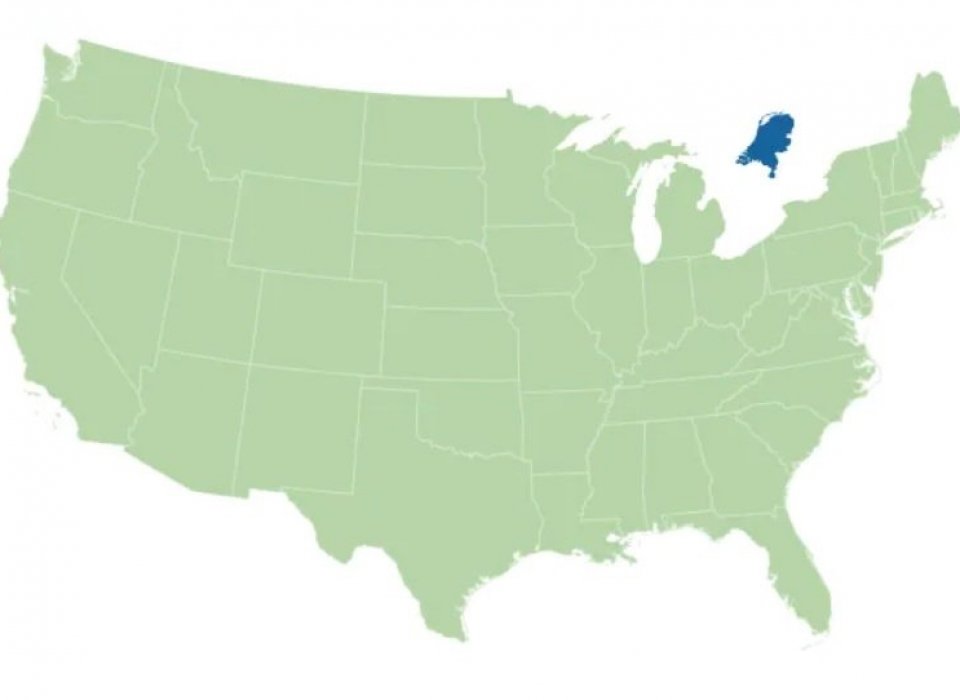
The rallying cry in the Netherlands started two decades ago, as concern mounted about its ability to feed its 17 million people: Produce twice as much food using half as many resources.
The country, which is a bit bigger than Maryland, not only accomplished this feat but also has become the world’s second-largest exporter of agricultural products by value behind the United States. Perhaps even more significant in the face of a warming planet: It is among the most effective agricultural and food technology exporters. The Dutch have pioneered cell-cultured meat, vertical farming, seed technology, and robotics in milking and harvesting — spearheading innovations that focus on decreased water usage and reduced carbon and methane emissions.
The Netherlands produces 4 million cows, 13 million pigs, and 104 million chickens annually and is Europe’s biggest meat exporter. But it also provides vegetables to much of Western Europe. The country has nearly 24,000 acres of crops grown in greenhouses, almost twice the size of Manhattan. With less fertilizer and water, these greenhouses can grow on a single acre, which would take 10 acres of traditional dirt farming. Dutch farms use only a half-gallon of water to grow about a pound of tomatoes, while the global average is more than 28 gallons.
More than half of the land in the Netherlands is used for agriculture. The Dutch often say their singular focus on food production is born of the severe famine the country experienced during World War II. But it could be argued that the preoccupation with food began in the 17th century when the Dutch were at the center of the global spice trade.
Their centrality in global food exploration is indisputable: Fifteen out of the top 20 largest agrifood businesses — Nestlé, Coca-Cola, Unilever, Cargill, and Kraft Heinz — have significant research and development centers in the Netherlands.
With their limited land and rainy climate, the Dutch have become masters of efficiency. But there are challenges: The greenhouse industry has flourished partly because of cheap energy, but Western Europe is facing soaring gas prices. And the country’s intensive animal agricultural practices are also at risk. This summer, a conservative government coalition pledged to halve nitrogen emissions by 2030, which would necessitate a dramatic reduction in the number of animals raised in the country. Farmers and ranchers have protested, and it remains to be seen how this standoff will be resolved.
Seeds
A worker at Syngenta pollinates a plant by hand in Enkhuizen.
Dutch companies are the world’s top suppliers of seeds for ornamental plants and vegetables. An area in the northwest called Seed Valley, where new varieties of vegetables and flowers are constantly developing. Enza Zaden is headquartered here, just north of Amsterdam.
In three generations, Enza Zaden has evolved from a family-owned seed shop into a global market leader in vegetable breeding, with more than 2,500 employees and 45 subsidiaries in 25 countries.
Jaap Mazereeuw, Enza Zaden’s managing director, said the company spends $100 million annually on research, introducing about 150 new vegetable varieties yearly.
“We are very much a research company,” he said. “With climate change, we are seeing the weather becoming more extreme. We’re looking at resilient varieties, seeds for organic farms, and more salt-tolerant varieties for places where water quality is not good. We need to find solutions for subsistence farmers up to large-scale farmers.”
Employees at Enza Zaden, one of the biggest vegetable-breeding companies in the world, store DNA samples.
The climate room at Incotec, a seed enhancement company in the Netherlands.

Robotic engineering helps the scientists at Enza Zaden manage the DNA samples more efficiently.
Seedlings grow without soil in controlled environments.
The company breeds seeds for all climatic zones and outdoor and indoor growing.
“We have our indoor farm here where we develop the varieties of the future, crops that can increase and be harvested quickly: lettuce, herbs, leafy crops. The genetics can be improved, as well as the whole technology — indoor farming will only become cheaper. It’s still early days for the industry,” Mazereeuw said.
The inside of a greenhouse where lettuce on the water is being produced in Maasbree.
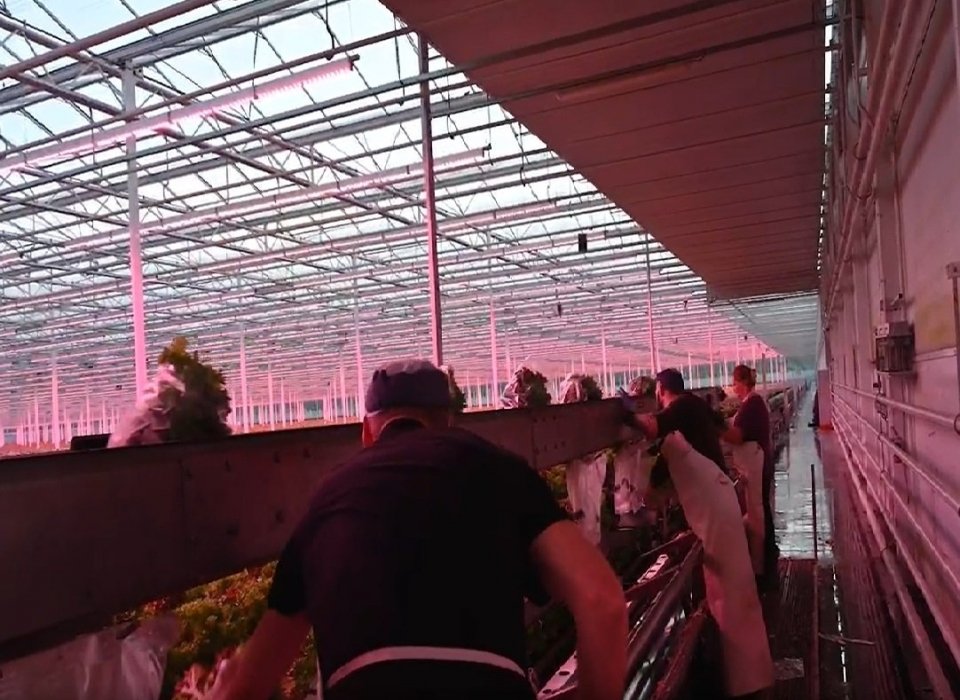
Lettuce is bagged for sale inside a Siberia Greenhouse facility in Maasbree.
More than 12 billion heads of lettuce are grown each year from Enza Zaden’s seeds, but it was a tomato in the early 1960s that really put the company on the map — and perhaps what, in turn, put the Netherlands on the map for tomatoes. The country’s greenhouses produce nearly a million tons of tomatoes, with exports totaling around $2 billion annually.
“There’s a new tomato virus, and we recently found the resistance to that virus in our seed bank,” Mazereeuw said. The company stores its seeds in a temperature-controlled vault — called a seed bank — to preserve genetic diversity. Still, because seeds don’t stay viable forever, each stored variety must be grown out, and those seeds, in turn, must be saved. It is all of vital importance, Mazereeuw said: “If we talk about food or clothes or energy or animal husbandry — everything starts with plants.”
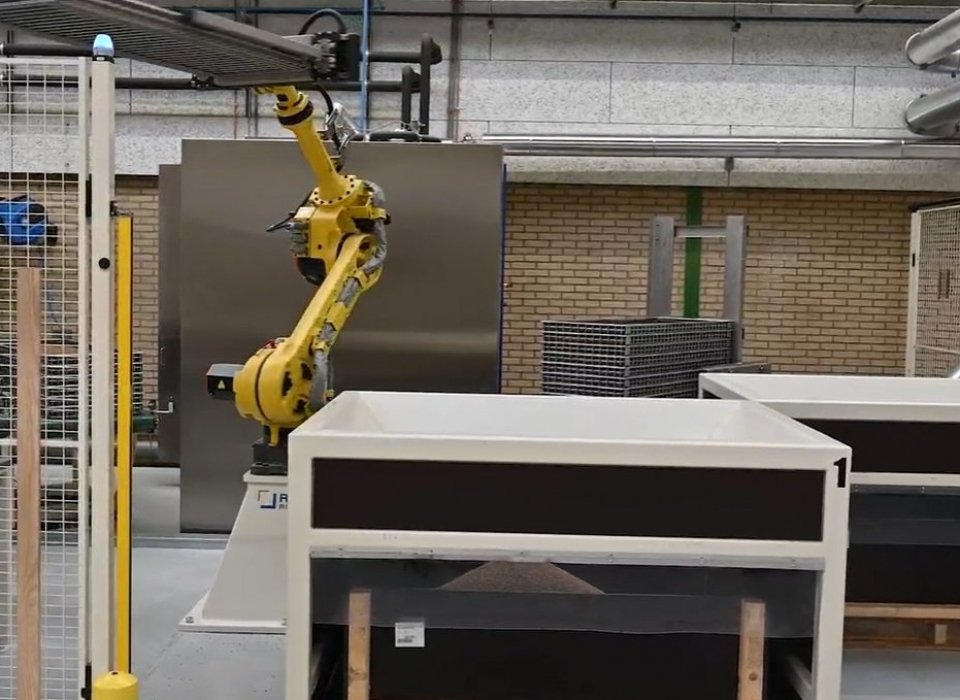
Bejo Seeds is a vegetable breeding company in Warmenhuizen. The robot cleans and sorts the seeds.
In this photo, lettuce seedlings are grown on a vertical farm at B-Four Agro before planting them in the greenhouse, where they grow on water.
Produce
A technician walks between walls growing cucumbers at PlantLab in Amsterdam. PlantLab specializes in technology for urban farming and has the biggest indoor farm in Europe, located in the heart of Amsterdam in the former IBM typewriter factory.
Nature is brutal. There can be too much sun. Or not enough. Bugs maraud. Rain washes seeds away.
“We believe we can do much better than nature,” said Eelco Ockers, chief executive of PlantLab, which develops and operates custom-built indoor farms worldwide — systems they call “plant production units.” Indoor vertical farmers trade in the sun's free power for much more expensive electric light. Still, the benefit is they can much more easily control every variable to get consistent and reliable yield, Ockers said.
Gitzels Plant Nursery grows young plants for vegetable growers and seed companies inside 25 acres of innovative greenhouses.
B-Four Agro, located in Warmenhuizen, grows lettuce and celery in greenhouses on water beds. The seedlings are first produced in a vertical farm before moving to the water.
The three founders put together their prototype in 2008 and launched the company in 2010, helping Dutch greenhouse and indoor farmers increase yields with LED lights even when the technology was in its infancy. They have a system whereby enough crops to supply 100,000 residents daily with nearly half a pound of fresh vegetables each can be grown in an area no larger than two football fields.
Indoor vertical farmers trade in the free power of the sun for much more expensive electric light
Koppert Cress is located in Westland. The company grows seedlings, edible leaves, and flowers in its innovative greenhouses.
Koppert Cress uses LED lights to help improve the yield and quantity of crops, as well as to help intensify the flavor, aroma, and presentation of the produce it grows.
Earlier this year, PlantLab received 50 million euros (about $51.6 million) in investment capital to open more production sites outside the Netherlands to grow vegetables without pesticides or herbicides on a large scale very close to its consumers. The company aims to expand more broadly in the United States, Asia, and Latin America in the next five years and to have 250 acres of vertical farms worldwide in the next ten years.
PlantLab’s research and development center in Den Bosch is the largest such center for vertical farming in the world, and it uses limited light spectrum LEDs and plastic stacked production trays. The plants grow in vermiculite with their roots in water. “Nothing is hand-harvested. Human hands touch nothing,” Ockers said. The water is recirculated, meaning no water is lost in the growing process. For now, the system is most effective for growing leafy greens, herbs, and tomatoes, but he said cucumbers, zucchini, and all types of berries suit this growing system. And by limiting the time between harvest and consumption, food waste is minimized, and nutrient density is much higher than in traditionally grown crops.
Lettuces are grown on the water in a Siberia Greenhouse system in Maasbree.

Large-scale strip trials are being conducted to see whether a robust, plant-based food production system can be created.
Picked tomatoes are loaded onto robotic cars to be transported to the packing department at Agro Care.
If you were born in the city of glass, you would work in the city of glass,” said Kees van Veen. Although it sounds like the start of a science-fiction novel, he was speaking about Westland, close to Rotterdam, where 80 percent of agricultural land is in glass greenhouses. He and his friend Philip van Antwerpen bucked the odds, leaving Westland and starting Agro Care about an hour south in 1997, in an area close to the sea with lots of sun hours, winters that aren’t too cold, and summers that aren’t too hot.
In 25 years, they grew to have 645 acres of tomatoes under glass and 1,500 employees. Their goal is to double that by 2030.
Agro Care is one of the leading tomato producers in Europe.
The strings, which must be placed by hand, help the plant grow toward the sun.
The company was one of the first tomato growers to supplement natural light with artificial light and has grown into one of the largest tomato producers in Europe, producing nearly 200 million pounds a year, now with growing facilities in Morocco and Tunisia.
Axia Vegetable Seeds provides the majority of tomato seeds to Agro Care. This is their seed storage for tomato seeds in Naaldwijk. A kilogram of tomato seeds is more valuable than a kilogram of gold.
Employees at Agro Care check for viruses at the tops of tomato plants.
The tomato plants are grown in small bags of Rockwool substrate, like housing insulation, through which water introduces nutrients.
Agro Care also has greenhouses in Tunisia, Morocco, and France.
The company’s significant achievement is changing the reputation of Dutch tomatoes — they’ve historically been known for hard, flavorless tomatoes harvested green. In 2000, Agro Care started with lights above the tomatoes, harvesting them on the vine fully ripe. A quarter of the tomatoes stay in the Netherlands, while the rest are shipped all over Europe.
Because of intensive electricity needs, Agro Care started its small energy company. The carbon dioxide generated is used as a nutrient for the crop, piped into the greenhouses via giant ventilators, where it is turned into oxygen by the plants. The upshot is 99 percent efficiency and much less carbon dioxide released into the atmosphere.
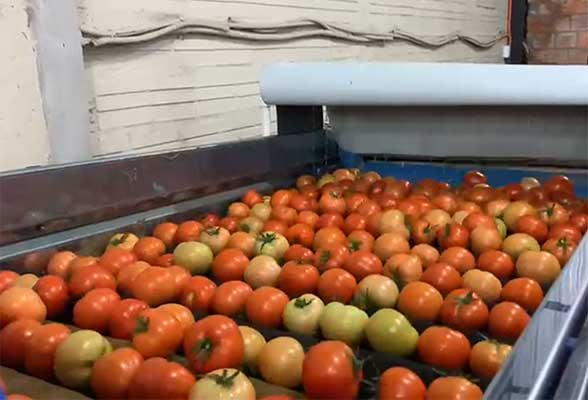
Greenpack and Harvest House partner in packaging a large share of Dutch tomatoes, a significant portion of which are for export.
Dutch tomatoes are packed, many for export, in Maasdijk.
ONIONS
Harvested onions at Michiel van Andel’s farm in Emmeloord.
Animals

Pig farmer Ruud van Dijk practices circular agriculture to create waste-free pig farming at his farm in Oirlo.
The Netherlands is the biggest exporter of meat in the European Union. In 2020, it exported 8.8 billion euros (about $9 billion) worth of pork, beef, and poultry, primarily to Germany (beef and veal), Britain (poultry), and China (mainly pork).
Vion Food Group has 12 production locations for pigs. Four of these are in the Netherlands, and eight are in Germany. The company slaughters 15 million pigs and almost 1 million cows annually — more than half of all Dutch pigs and nearly 40 percent of Germany’s swine herd. Boxtel, a town in the southern Netherlands, is home to Vion’s largest pig slaughter facility, dispatching 20,000 pigs daily. Vion uses artificial intelligence to detect and flag signs of animal cruelty and to minimize animal stress. In many US slaughter facilities, crowding and high noise levels can increase animals’ fear, and animals are frequently killed via electrocution, which many experts say is less humane.
Pigs ready for slaughter are 175 days old and weigh about 265 pounds. Upon arrival by truck from regional farms, 80 pigs are herded off a platform and into the facility, and a veterinarian checks for sick or wounded animals.
Theo Vernooij is a pig farmer in Nijkerk. He has around 7,000 pigs.
Animals are led to the stunning area, sedated by carbon monoxide gas. Once the animals are anesthetized, they are hung by their legs and killed swiftly via stabbing.
The pigs are anesthetized in a gas chamber before being killed.
Blood samples are taken to verify the health of animals before the carcasses are dipped in a hot bath to remove bristles. The remainder is burned off at high temperatures (which also kills bacteria). Pigs are cut in half longitudinally and then cooled from 98.6 degrees down to 44 degrees Fahrenheit.
Workers at Vion do singular jobs in the assembly line to manage the process efficiently.
The pigs are dunked into hot water baths, which kill bacteria after they have been slaughtered.
From there, animals are processed into hams, shoulders, and middles, with much of the butchering done by hand. Internal organs are sold to China, and for pet food, hams are often sold to Italy, and ribs may find their way to major restaurant chains in the United States.
The heads, feet, kidneys, and hearts of pigs slaughtered at Vion are exported to China and used in pet food production.
The famous Dutch wafer cookies, stroopwafels, are ready to be ground into food for pigs and chickens at the Nijsen company based in Veblen. It uses discarded food — including sweets, bread, doughnuts, and cream cakes — as feed.
COWS
Cows in Waterland, near Amsterdam. The Netherlands has 3.8 million cattle, 1.5 million of which are dairy cows.
Moma is an organic dairy farm outside Amsterdam in Weesp.
Egg company Kipster brands itself as a revolutionary chicken farm. It says it is almost climate neutral, and the chickens have more space to roam than many other farms.
Kipster is an egg company that aims to improve animal welfare, tackle food waste, and produce certified carbon-neutral eggs. Farms incorporate natural light and fresh air, and chickens are free from cages to pursue their instincts and animal natures. And in a departure from the global practice of killing male chicks that are irrelevant in the egg-laying business, the males are kept and raised for meat.
Kipster chickens are fed entirely with food waste from supermarkets and food manufacturers rather than with commodity grains. Thirty percent of the world’s grain production is for animal feed, but “I’d rather use all arable land to produce cereals for people,” said managing director Ruud Zanders.
We're one of only poultry farmers in the world saying it's better to eat fewer eggs

A Kipster employee checks the eggs in a quality-control production line in Castenray.
A poultry farm in Dronten, Netherlands.
“We need to close the gap between what we’re doing as farmers and what people want,” which is more ethically and sustainably produced food, Zanders said.
Four entrepreneurs launched Kipster in 2017 and now have three farms in the Netherlands and a farm in North Manchester, Ind., from which Kroger buys all of Kipster’s eggs. By next June, there will be four farms in the United States, with each house containing 24,000 birds, and each of the facilities will be open to the public to observe animal welfare practices.
Farms have indoor gardens with skylights, trees, tree trunks for climbing, and ground for pecking (the birds are not de-beaked). With zero emissions, the farms’ energy is generated by solar panels. Zanders uses Dekalb White chickens — a calm and sociable breed. White birds and white eggs have a 5 percent lower carbon footprint than brown birds and brown eggs (brown birds are a bit bigger and eat more, and white birds and eggs reflect the sun more effectively). Adult male birds and females at the end of their productivity are used primarily for meatballs sold in Europe by the Lidl grocery chain, which also buys all of Dutch Kipster’s eggs.
“We need to close the gap between what we’re doing as farmers and what people want.”
— Ruud Zanders, managing director of Kipster

The Netherlands produces 104 million chickens annually.
Chicks at an Optibrut farm, which delivers day-old chicks to chicken farmers.
The concept was developed with input from the Dutch Society for Prevention of Cruelty to Animals and Wageningen University & Research to maximize animal welfare and ensure flexibility and scalability. With an easy-to-assemble modular construction, Zanders said, the Kipster model is replicable and suitable for urban agriculture.
In early 2023, Kipster will open a farm in the United States.
Exports
APM Terminals is one of the primary container terminals in the port of Rotterdam, which in turn is the largest freight port in Europe and the tenth largest in the world, handling 97 percent of the country’s 20-foot import/export containers.
In 2021, Dutch agricultural exports set a record, reaching 105 billion euros (about $108.4 billion), according to Wageningen Economic Research and Statistics Netherlands. This growth was attributable to higher prices and increased volume. Since 1995, Dutch crop and agricultural animal production volume has grown by 20 percent without significantly increasing natural gas consumption and with reduced fertilizer use.
B-Four Agro workers cut vegetables to be later packaged.
Hessing is one of two plants where vegetables are precut in the Netherlands. These green beans are being cleaned, cut, and packaged at a plant in Zwaagdijk.

The distribution center of Albert Heijn in Zaandam.
Of last year’s exports, 12 billion euros (about $12.4 billion) were in ornamental horticulture (flowers, plants, bulbs, and tree nursery products). Still, the next most profitable agricultural category was fruits and vegetables, followed by meat and dairy. A quarter of total agricultural exports went to Germany, and the three next largest markets were Belgium, France, and Britain, with onions and tomatoes topping the list of exports.
The rising export dominance is partly attributable to research and development financial resources, which have tripled in the past three decades, focusing on increasing yield while decreasing energy, water, and input dependence (the country’s greenhouses have nearly eliminated the use of pesticides).
Because of its geographic centrality, the Netherlands, primarily via the Rotterdam port, has also become one of the world’s foremost “re-exporters,” making it a commercial and logistical trade hub for many goods sold into the eurozone from countries like the United States and China (since Brexit, re-exported business to Britain has declined somewhat). A fifth of all fresh fruit and vegetables imported into Europe comes via a Dutch port.
A Brazilian ship is carrying soy discharges at the Bunge facility at the port of Amsterdam.
Schiphol Airport, near Amsterdam, is the leading international airport in the Netherlands and the busiest airport in Europe regarding aircraft movement. Last year it processed a record 1.66 million tons of cargo, although the war in Ukraine has meant a passenger and cargo slowdown for 2022 because of Western sanctions.
The airport is constructing a new terminal building with a fully automated system for storage and retrieval, with 12 stacker cranes and space to store 2,500 pallets. Slated to be operational by 2024, it will deploy automated guided vehicles to increase the efficiency of cargo movement, as well as “smart gates,” which will automatically record the volume and weight of all incoming shipments through 3D scans.
The distribution center of Albert Heijn, the largest Dutch supermarket in Zaandam, Netherlands.
Albert Heijn is the largest Dutch supermarket chain, accounting for 35 percent of the nation’s sales. Partnering with Vanderlande in 2018, the grocery chain debuted a fully automated regional distribution center for nonperishable products in Zaandam, which obviates the need for human oversight and manual lifting from product arrival into the facility to its loading onto trucks for distribution to individual stores. Using artificial intelligence, optimal stacking, and grouping of products to be delivered together, the system minimizes truck trips and, thus, fuel use. The facility, equipped with 11,000 solar panels, is among the assets that have enabled the grocery chain to lower its carbon dioxide emissions by 92 percent. For the company’s remaining energy needs, it purchases 100 percent Dutch wind energy and has installed 310,000 LED lights, resulting in a 50 percent energy savings.
Food delivery in the center of Amsterdam at Albert Heijn, the biggest supermarket in the Netherlands.
A Picnic worker collects products for a customer's order. Picnic is a company that delivers groceries
The fruit and vegetable market for retail and restaurants in Amsterdam.
For more information, a film about food production in the Netherlands can be seen here: vpro.nl/foodforthought [vpro.nl]
About this story
Editing by Bronwen Latimer and Sandhya Somashekhar.
Video editing by Luis Velarde. Design and development by Tucker Harris.
Design editing by Joe Moore. Graphics by Lauren Tierney.
Copy editing by Brandon Standley and Jordan Melendrez.
Project management by Jay Wang and Courtney Kan.
___________________________
Related Articles Recently Posted on www.buildingthebridgefoundation.com:
Our Friday News Analysis | 'In Search of a Nation's Soul (Part 12),' 24 November 2022.
The Evangelical Pope| 'Peace: the Work of Justice and Love …,' 28 November 2022.
The views expressed are solely those of the author and may or may not reflect those of the Building the Bridge Foundation, The Hague.
LATEST OPEN LETTERS
-
21-07Freedom
-
20-03Stand up to Trump
-
18-02Average Americans Response
-
23-12Tens of thousands of dead children.......this must stop
-
05-06A Call to Action: Uniting for a Lasting Peace in the Holy Land
-
28-05Concerned world citizen
-
13-02World Peace
-
05-12My scream to the world
-
16-11To Syria and Bashar al-Assad
-
16-11To Palestine
VIRTUAL POST OFFICE
PETITIONS
LINKS
DONATION
Latest Blog Articles
-
04-12Our Friday News Analysis | What the World Reads Now!
-
03-12Our Wednesday News Analysis | Gaza’s Darkest Lesson: Exposing the True Allies and Enemies of Palestine
-
02-12Gaza’s Darkest Lesson: Exposing the True Allies and Enemies of Palestine
-
02-12Analysis The Visionary Palestinian Peace Plan for Israel and Gaza That You've Never Heard Of
-
02-12Israel’s collective amnesia
-
01-12The Evangelical Pope | The Meaning of Human Freedom
-
27-11Our Friday News Analysis | What the World Reads Now!
-
26-11Our Wednesday News Analysis | Who is Ready to Die for Trump’s Gaza Plan? So Far, Nobody
-
25-11Who is Ready to Die for Trump’s Gaza Plan? So Far, Nobody
-
25-11The eternal Zionist contempt for agreements and peace
-
25-11Jewish communities must confront their complicity in Israel's genocide
Latest Comments
 One of the most important and illuminating articles that I …
One of the most important and illuminating articles that I …
Comment by Benjamin Inbaraj And what's wrong here?
After all, there is the homeland …
And what's wrong here?
After all, there is the homeland …
Comment by Isac Boian Does this reinforce or deny my argument that Israel is …
Does this reinforce or deny my argument that Israel is …
Comment by Edward Campbell Many 'say' they support the Palestinian cause but do little …
Many 'say' they support the Palestinian cause but do little …
Comment by Philip McFedries The UN is strangled by the "war for profit" cabal …
The UN is strangled by the "war for profit" cabal …
Comment by Philip McFedries I can't read the printing on the map.
I can't read the printing on the map.
Comment by Philip McFedries Good news!
Good news!
Comment by Philip McFedries




































COMMENTS
This article has 0 comments at this time. We invoke you to participate the discussion and leave your comment below. Share your opinion and let the world know.